Newbury
The Boston area was first settled by people escaping from religious persecution in England, in the north of Massachusetts the settlers were English tradesmen who had a different objective; they were seeking new opportunities. In 1634 the Reverend Thomas Parker and around 100 settlers from Wiltshire in England landed at Agawam (now Ipswich). They spent the winter there but in the spring of 1635 they moved north to the Quascacunquen River (now the Parker River) to found a plantation. The plantation was named Newbury, after the town in Berkshire, England. Why did folks from Wiltshire name their plantation after a town in Berkshire? It seems that it was named by the House of Deputies before the settlers moved up there, but it may be significant that Thomas Parker had taught in a school in Newbury, Berkshire. The plantation had an abundant supply of hay from the salt marsh and by so the town quickly developed as a stock rearing centre. Other early industries in the town included tanning and shipbuilding. A powder mill was set up here in 1639, probably the first in the colonies. The construction of a bridge across the Merrimack River just to the north west of Newbury attracted commerce to the area close to the bridge. This became the main commercial centre of the town and in 1764 it became a separate town called Newburyport. This left Newbury as just a fishing and farming community. Nowadays Newbury is a quiet town with a rich heritage.
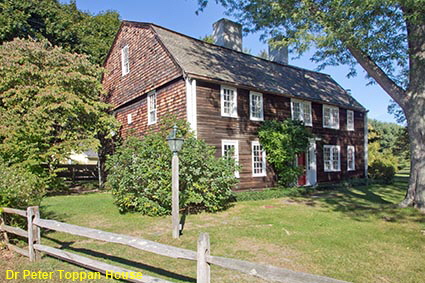
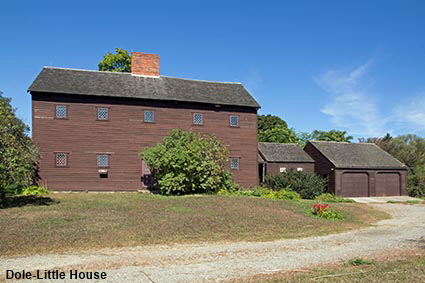
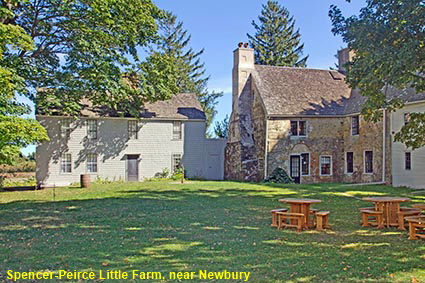
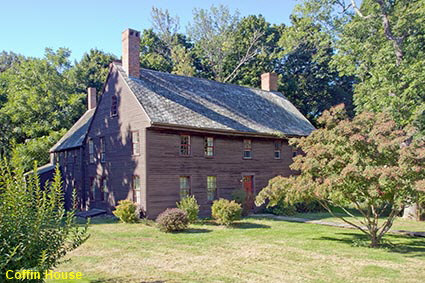
DLU171022
Click on Minimap to navigate


To move forwards or backwards through the Essex County trail click the arrows above, or select your next destination on the Minimap.
Coffin House
We have left the oldest building on the page to last. The Coffin House is thought to date back to 1678 when a family home of two or possibly three rooms was built on land owned by Tristram Coffin, Jr. By 1712 the house needed to be extended to provide accommodation for a married son and his family, so work began to more than double its size. Over the years, the Coffin family grew and so lean-to structures were added to further extend the house. In 1785 two Coffin brothers legally divided the house into two separate dwellings, each with its own kitchen and living spaces. The house was owned by seven generations of the Coffin family until 1929 when it was sold to Historic New England. As a result of the regular additions to the structure, it has rooms from the seventeenth, eighteenth, and nineteenth centuries. The Coffin House is open to the public the 1st and 3rd Saturdays of the month from June to mid October.
Dole-Little House
Newbury was founded on cattle rearing and it plays a strong part in the history of this house which was built around 1715. Richard Dole was a cattleman and he built this house using materials salvaged from an earlier structure. It was a two-room house with a central-chimney and a small kitchen shed at the rear. The shed was later replaced with a larger lean-to. In 1954 Florence Evans Bushee acquired the house and set about the task of restoring it. During this restoration workers discovered the evidence of old mortise and tenon joints that showed that the beams were originally made for another building. The lean-to was removed during the restoration and reconstructed with new timbers, also small-paned sash windows from the front of the house were moved to the reconstructed lean-to. The Dole-Little House is open to the public a few times a year, check the web site for dates.
Spencer-Peirce Little Farm, near Newbury
John Spencer was an early settler who in 1635 was granted 162 hectares (400 acres) of land just outside Newbury. He was an investor in the stock rearing venture that drove the early settlement of Newbury. In 1637 he was accused of being a member of a heretical sect so he left his land and property to his nephew and returned to England where he died in 1648. Daniel Peirce purchased the property in 1651 by which time the amount of land had shrunk to 93 hectares (230 acres). He used the farm to rear cattle and produce crops as well as blacksmithing and malt making. When Peirce died in 1677 he left the farm to his son, Colonel Daniel Peirce. The farm was later owned by a Newburyport merchant then for more than 100 years by the Little family. In 1986 it passed to Historic New England. By then the buildings were in a poor state of repair and it cost more than $1m over 6 years to restore them. The main farmhouse dates back to 1690 or possibly earlier, making it one of the oldest stone buildings in Massachusetts. The Spencer-Peirce Little Farm has been restored complete with a range of animals and is open to the public Thursday to Sunday from June to mid October. Click tab 2 to see the lounge of the Tenant Farmhouse.
Dr Peter Toppan House
Peter Toppan was born in England at Salisbury, Wiltshire in 1634. When he was aged 3 his family moved to the colonies and settled in Newbury. Toppan grew up to become the town physician. In 1697 he built this house for his family on Newbury's High Street, near the corner of Marlboro Street. Dr. Toppan died in 1707 and the house passed to his son, Samuel. In the late nineteenth century the house was altered to accommodate two families but it was restored to a single family dwelling in the mid-twentieth century. It remains a private residence and is not open to the public.
Home > US States > New England > Massachusetts > Essex County >
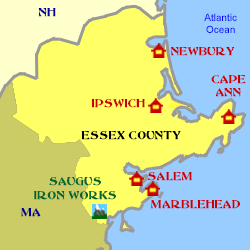

© Mike Elsden 1981 - 2025
The contents of this page may not be reproduced in full or in part without permission